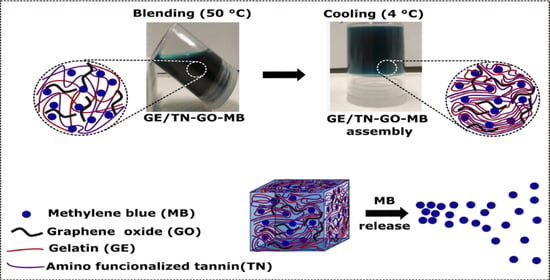Thermo- and pH-Responsive Gelatin/Polyphenolic Tannin/Graphene Oxide Hydrogels for Efficient Methylene Blue Delivery
Abstract
:1. Introduction
2. Results and Discussion
2.1. Hydrogel Formation
2.2. Characterization
2.3. Disintegration/Dissolution In-Vitro and Water Uptake
2.4. Methylene
2.5. Transport Mechanism of MB from the Hydrogels
3. Materials and Methods
3.1. Materials
3.2. The Amino-Functionalized Polyphenolic Tannin (TN) Purification
3.3. Hydrogel Preparation
3.4. Characterization
3.5. Hydrogel Disintegration/Dissolution
3.6. Swelling Degree
3.7. Methylene Blue Release In Vitro
3.8. Statistical Analysis
4. Conclusions
Supplementary Materials
Author Contributions
Funding
Institutional Review Board Statement
Informed Consent Statement
Data Availability Statement
Acknowledgments
Conflicts of Interest
Sample Availability
References
- Souza, P.R.; de Oliveira, A.C.; Vilsinski, B.H.; Kipper, M.J.; Martins, A.F. Polysaccharide-Based Materials Created by Physical Processes: From Preparation to Biomedical Applications. Pharmaceutics 2021, 13, 621. [Google Scholar] [CrossRef] [PubMed]
- Tanwar, A.; Date, P.; Ottoor, D. ZnO NPs Incorporated Gelatin Grafted Polyacrylamide Hydrogel Nanocomposite for Controlled Release of Ciprofloxacin. Colloids Interface Sci. 2021, 42, 100413. [Google Scholar] [CrossRef]
- Chen, H.; Wu, D.; Ma, W.; Wu, C.; Tian, Y.; Wang, S.; Du, M. Strong Fish Gelatin Hydrogels Enhanced by Carrageenan and Potassium Sulfate. Food Hydrocoll. 2021, 106841. [Google Scholar] [CrossRef]
- de Bezerra, E.O.T.; Berton, S.B.R.; de Oliveira, A.C.; Souza, P.R.; Vecchi, C.F.; Bruschi, M.L.; Vilsinski, B.H.; Martins, A.F. The Cooling of Blends in Water Supports Durable, Thermo-Responsive, and Porous Gelatin-Polyphenolic Tannin Assemblies with Antimicrobial Activities. Mater. Today Commun. 2021, 26, 101883. [Google Scholar] [CrossRef]
- Leite, M.L.; Soares, D.G.; Anovazzi, G.; de Oliveira, C.A.; Hebling, J.; de Souza Costa, C.A. Fibronectin-Loaded Collagen/Gelatin Hydrogel Is a Potent Signaling Biomaterial for Dental Pulp Regeneration. J. Endod. 2021. [Google Scholar] [CrossRef]
- Pei, Y.; Chu, S.; Chen, Y.; Li, Z.; Zhao, J.; Liu, S.; Wu, X.; Liu, J.; Zheng, X.; Tang, K. Tannin-Immobilized Cellulose Hydrogel Fabricated by a Homogeneous Reaction as a Potential Adsorbent for Removing Cationic Organic Dye from Aqueous Solution. Int. J. Biol. Macromol. 2017, 103, 254–260. [Google Scholar] [CrossRef]
- Ma, M.; Zhong, Y.; Jiang, X. Thermosensitive and PH-Responsive Tannin-Containing Hydroxypropyl Chitin Hydrogel with Long-Lasting Antibacterial Activity for Wound Healing. Carbohydr. Polym. 2020, 236, 116096. [Google Scholar] [CrossRef]
- Facchi, S.P.; de Oliveira, A.C.; Bezerra, E.O.T.; Vlcek, J.; Hedayati, M.; Reynolds, M.M.; Kipper, M.J.; Martins, A.F. Polycationic Condensed Tannin/Polysaccharide-Based Polyelectrolyte Multilayers Prevent Microbial Adhesion and Proliferation. Eur. Polym. J. 2020, 130, 109677. [Google Scholar] [CrossRef]
- Priyadarsini, S.; Mohanty, S.; Mukherjee, S.; Basu, S.; Mishra, M. Graphene and Graphene Oxide as Nanomaterials for Medicine and Biology Application. J. Nanostruct. Chem. 2018, 8, 123–137. [Google Scholar] [CrossRef] [Green Version]
- Abazari, M.F.; Nasiri, N.; Nejati, F.; Kohandani, M.; Hajati-Birgani, N.; Sadeghi, S.; Piri, P.; Soleimanifar, F.; Rezaei-Tavirani, M.; Mansouri, V. Acceleration of Osteogenic Differentiation by Sustained Release of BMP2 in PLLA/Graphene Oxide Nanofibrous Scaffold. Polym. Adv. Technol. 2021, 32, 272–281. [Google Scholar] [CrossRef]
- Shen, X.; Dong, L.; He, X.; Zhao, C.; Zhang, W.; Li, X.; Lu, Y. Treatment of Infected Wounds with Methylene Blue Photodynamic Therapy: An Effective and Safe Treatment Method. Photodiagn. Photodyn. Ther. 2020, 32, 102051. [Google Scholar] [CrossRef]
- Yoneda, J.S.; de Araujo, D.R.; Sella, F.; Liguori, G.R.; Liguori, T.T.A.; Moreira, L.F.P.; Spinozzi, F.; Mariani, P.; Itri, R. Self-Assembled Guanosine-Hydrogels for Drug-Delivery Application: Structural and Mechanical Characterization, Methylene Blue Loading and Controlled Release. Mater. Sci. Eng. C 2021, 121, 111834. [Google Scholar] [CrossRef]
- Vilsinski, B.H.; Souza, P.R.; de Oliveira, A.C.; Filho, C.M.C.; Valente, A.J.M.; Muniz, E.C.; Borges, O.; Gerola, A.P.; Caetano, W.; Martins, A.F. Photophysics and Drug Delivery Behavior of Methylene Blue into Arabic-Gum Based Hydrogel Matrices. Mater. Today Commun. 2021, 26, 101889. [Google Scholar] [CrossRef]
- Neklyudov, A.D. Nutritive Fibers of Animal Origin: Collagen and Its Fractions as Essential Components of New and Useful Food Products. Appl. Biochem. Microbiol. 2003, 39, 229–238. [Google Scholar] [CrossRef]
- Goenka, S.; Sant, V.; Sant, S. Graphene-Based Nanomaterials for Drug Delivery and Tissue Engineering. J. Control. Release 2014, 173, 75–88. [Google Scholar] [CrossRef] [PubMed]
- Ashutosh Padhan, B.K.; Nanda, B.C. Behera Floating Oral In-Situ Gel, a Comprehensive Approach of Gastro-Retentive Drug Delivery Syestem: A Review. IJPSR 2019, 10, 4026–4039. [Google Scholar]
- Paulino, A.T.; Guilherme, M.R.; Reis, A.V.; Campese, G.M.; Muniz, E.C.; Nozaki, J. Removal of Methylene Blue Dye from an Aqueous Media Using Superabsorbent Hydrogel Supported on Modified Polysaccharide. J. Colloid Interface Sci. 2006, 301, 55–62. [Google Scholar] [CrossRef] [PubMed]
- Zandi, M.; Mirzadeh, H.; Mayer, C. Early Stages of Gelation in Gelatin Solution Detected by Dynamic Oscillating Rheology and Nuclear Magnetic Spectroscopy. Eur. Polym. J. 2007, 43, 1480–1486. [Google Scholar] [CrossRef]
- Chen, B.; Cai, Y.; Liu, T.; Huang, L.; Zhao, X.; Zhao, M.; Deng, X.; Zhao, Q. Formation and Performance of High Acyl Gellan Hydrogel Affected by the Addition of Physical-Chemical Treated Insoluble Soybean Fiber. Food Hydrocoll. 2020, 101, 105526. [Google Scholar] [CrossRef]
- Rao, M.A. Rheological Behavior of Processed Fluid and Semisolid Foods. In Rheology of Fluid and Semisolid Foods; Food Engineering Series; Springer: Boston, MA, USA, 2007; pp. 223–337. ISBN 978-0-387-70929-1. [Google Scholar]
- da Silva, E.P.; Guilherme, M.R.; Garcia, F.P.; Nakamura, C.V.; Cardozo-Filho, L.; Alonso, C.G.; Rubira, A.F.; Kunita, M.H. Drug Release Profile and Reduction in the in Vitro Burst Release from Pectin/HEMA Hydrogel Nanocomposites Crosslinked with Titania. RSC Adv. 2016, 6, 19060–19068. [Google Scholar] [CrossRef]
- Abdullah, S.I.; Ansari, M.N.M. Mechanical Properties of Graphene Oxide (GO)/Epoxy Composites. HBRC J. 2015, 11, 151–156. [Google Scholar] [CrossRef]
- Facchi, D.P.; Lima, A.C.; de Oliveira, J.H.; Lazarin-Bidóia, D.; Nakamura, C.V.; Canesin, E.A.; Bonafé, E.G.; Monteiro, J.P.; Visentainer, J.V.; Muniz, E.C.; et al. Polyelectrolyte Complexes Based on Alginate/Tanfloc: Optimization, Characterization and Medical Application. Int. J. Biol. Macromol. 2017, 103, 129–138. [Google Scholar] [CrossRef]
- Ovchinnikov, O.V.; Evtukhova, A.V.; Kondratenko, T.S.; Smirnov, M.S.; Khokhlov, V.Y.; Erina, O.V. Manifestation of Intermolecular Interactions in FTIR Spectra of Methylene Blue Molecules. Vib. Spectrosc. 2016, 86, 181–189. [Google Scholar] [CrossRef]
- Somani, P.R.; Marimuthu, R.; Viswanath, A.K.; Radhakrishnan, S. Thermal Degradation Properties of Solid Polymer Electrolyte (Poly(Vinyl Alcohol)+phosphoric Acid)/Methylene Blue Composites. Polym. Degrad. Stabil. 2003, 79, 77–83. [Google Scholar] [CrossRef]
- Shimodaira, N.; Masui, A. Raman Spectroscopic Investigations of Activated Carbon Materials. J. Appl. Phys. 2002, 92, 902–909. [Google Scholar] [CrossRef]
- Chen, J.; Yao, B.; Li, C.; Shi, G. An Improved Hummers Method for Eco-Friendly Synthesis of Graphene Oxide. Carbon 2013, 64, 225–229. [Google Scholar] [CrossRef]
- López-Diaz, D.; Merchán, M.D.; Velázquez, M.M. The Behavior of Graphene Oxide Trapped at the Air Water Interface. Adv. Colloid Interface Sci. 2020, 286, 102312. [Google Scholar] [CrossRef]
- Berg, M.C.; Zhai, L.; Cohen, R.E.; Rubner, M.F. Controlled Drug Release from Porous Polyelectrolyte Multilayers. Biomacromolecules 2006, 7, 357–364. [Google Scholar] [CrossRef]
- Spizzirri, U.G.; Cirillo, G. (Eds.) Functional Hydrogels in Drug Delivery: Key Features and Future Perspectives, 1st ed.; CRC Press: Boca Raton, FL, USA, 2017; ISBN 978-1-315-15227-1. [Google Scholar]
- Park, M.-R.; Cho, C.-S.; Song, S.-C. In Vitro and in Vivo Degradation Behaviors of Thermosensitive Poly(Organophosphazene) Hydrogels. Polym. Degrad. Stabil. 2010, 95, 935–944. [Google Scholar] [CrossRef]
- Ghosh, A.K. Study of the Self-Association of Methylene Blue from Protonation Equilibriums. J. Am. Chem. Soc. 1970, 92, 6415–6418. [Google Scholar] [CrossRef]
- Dahiya, S.; Rani, R.; Kumar, S.; Dhingra, D.; Dilbaghi, N. Chitosan-Gellan Gum Bipolymeric Nanohydrogels—A Potential Nanocarrier for the Delivery of Epigallocatechin Gallate. BioNanoScience 2017, 7, 508–520. [Google Scholar] [CrossRef]
- Hua, S. Advances in Oral Drug Delivery for Regional Targeting in the Gastrointestinal Tract—Influence of Physiological, Pathophysiological and Pharmaceutical Factors. Front. Pharmacol. 2020, 11, 524. [Google Scholar] [CrossRef]
- Dinescu, S.; Ionita, M.; Pandele, A.M.; Galateanu, B.; Iovu, H.; Ardelean, A.; Costache, M.; Hermenean, A. In Vitro Cytocompatibility Evaluation of Chitosan/Graphene Oxide 3D Scaffold Composites Designed for Bone Tissue Engineering. Biomed. Mater. Eng. 2014, 24, 2249–2256. [Google Scholar] [CrossRef] [Green Version]
- Ritger, P.L.; Peppas, N.A. A Simple Equation for Description of Solute Release I. Fickian and Non-Fickian Release from Non-Swellable Devices in the Form of Slabs, Spheres, Cylinders or Discs. J. Control. Release 1987, 5, 23–36. [Google Scholar] [CrossRef]
- Ritger, P.L.; Peppas, N.A. A Simple Equation for Description of Solute Release II. Fickian and Anomalous Release from Swellable Devices. J. Control. Release 1987, 5, 37–42. [Google Scholar] [CrossRef]
- Peppas, N.A.; Sahlin, J.J. A Simple Equation for the Description of Solute Release. III. Coupling of Diffusion and Relaxation. Int. J. Pharm. 1989, 57, 169–172. [Google Scholar] [CrossRef]
- Mathematical Models of Drug Release. In Strategies to Modify the Drug Release from Pharmaceutical Systems; Elsevier: Amsterdam, The Netherlands, 2015; pp. 63–86. ISBN 978-0-08-100092-2.
- Raval, A.; Parikh, J.; Engineer, C. Mechanism of Controlled Release Kinetics from Medical Devices. Braz. J. Chem. Eng. 2010, 27, 211–225. [Google Scholar] [CrossRef]
- Moreira, R.C.L.; Oliveira, J.H.; Libel, G.P.; Amaral, P.E.R.; Pereira, E.C.A.; Siqueira, V.L.D.; Grassi, M.F.N.N.; Radovanovic, E. Modified Polystyrene Spheres/Graphene Oxide Decorated with Silver Nanoparticles as Bactericidal Material. J. Mol. Struct. 2021, 1233, 130091. [Google Scholar] [CrossRef]
- Zeng, X.; Ruckenstein, E. Control of Pore Sizes in Macroporous Chitosan and Chitin Membranes. Ind. Eng. Chem. Res. 1996, 35, 4169–4175. [Google Scholar] [CrossRef]
- Chen, P.-H.; Kuo, T.-Y.; Kuo, J.-Y.; Tseng, Y.-P.; Wang, D.-M.; Lai, J.-Y.; Hsieh, H.-J. Novel Chitosan–Pectin Composite Membranes with Enhanced Strength, Hydrophilicity and Controllable Disintegration. Carbohydr. Polym. 2010, 82, 1236–1242. [Google Scholar] [CrossRef]
- Nunes, C.S.; Rufato, K.B.; Souza, P.R.; de Almeida, E.A.M.S.; da Silva, M.J.V.; Scariot, D.B.; Nakamura, C.V.; Rosa, F.A.; Martins, A.F.; Muniz, E.C. Chitosan/Chondroitin Sulfate Hydrogels Prepared in [Hmim][HSO4] Ionic Liquid. Carbohydr. Polym. 2017, 170, 99–106. [Google Scholar] [CrossRef] [PubMed]
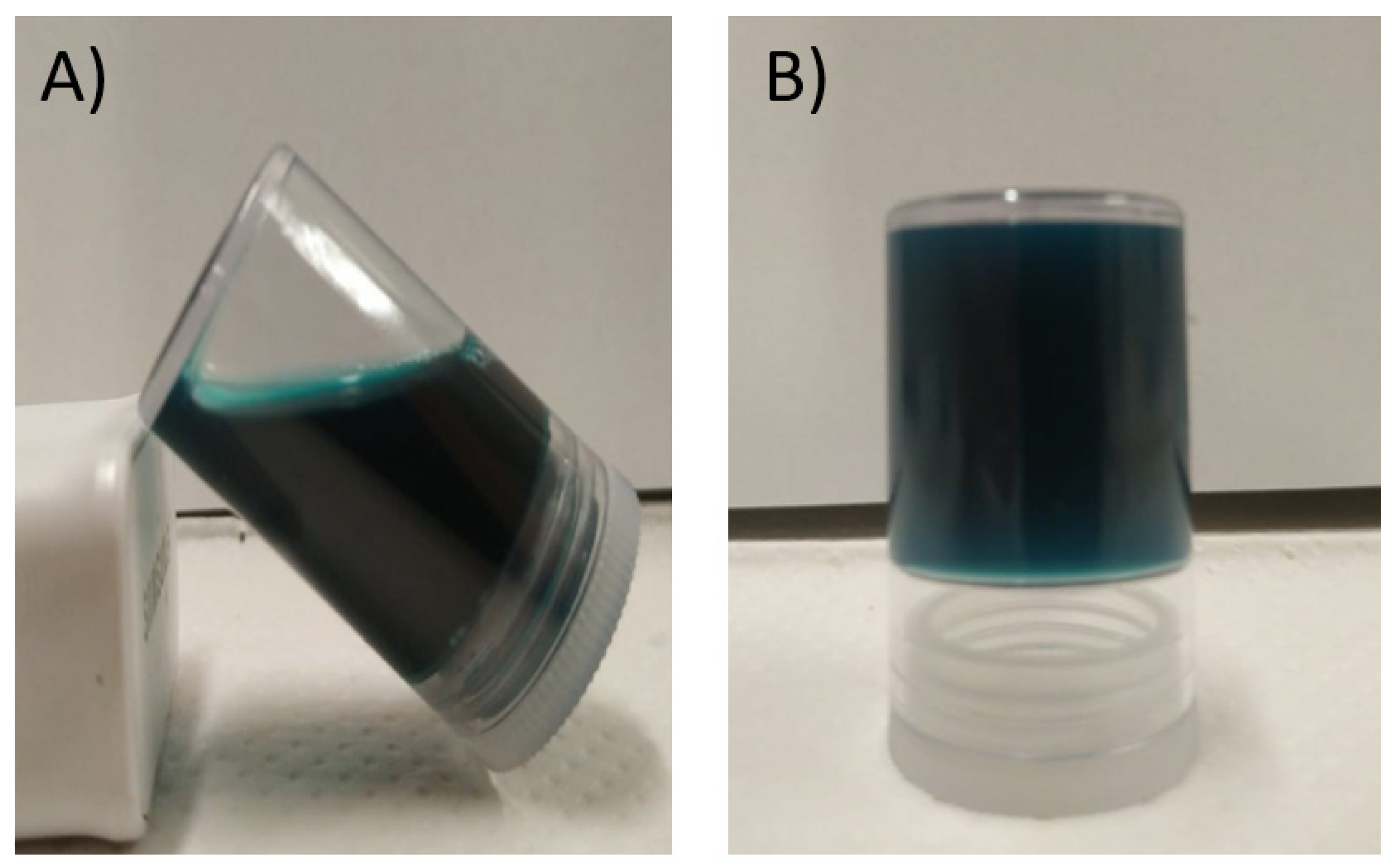
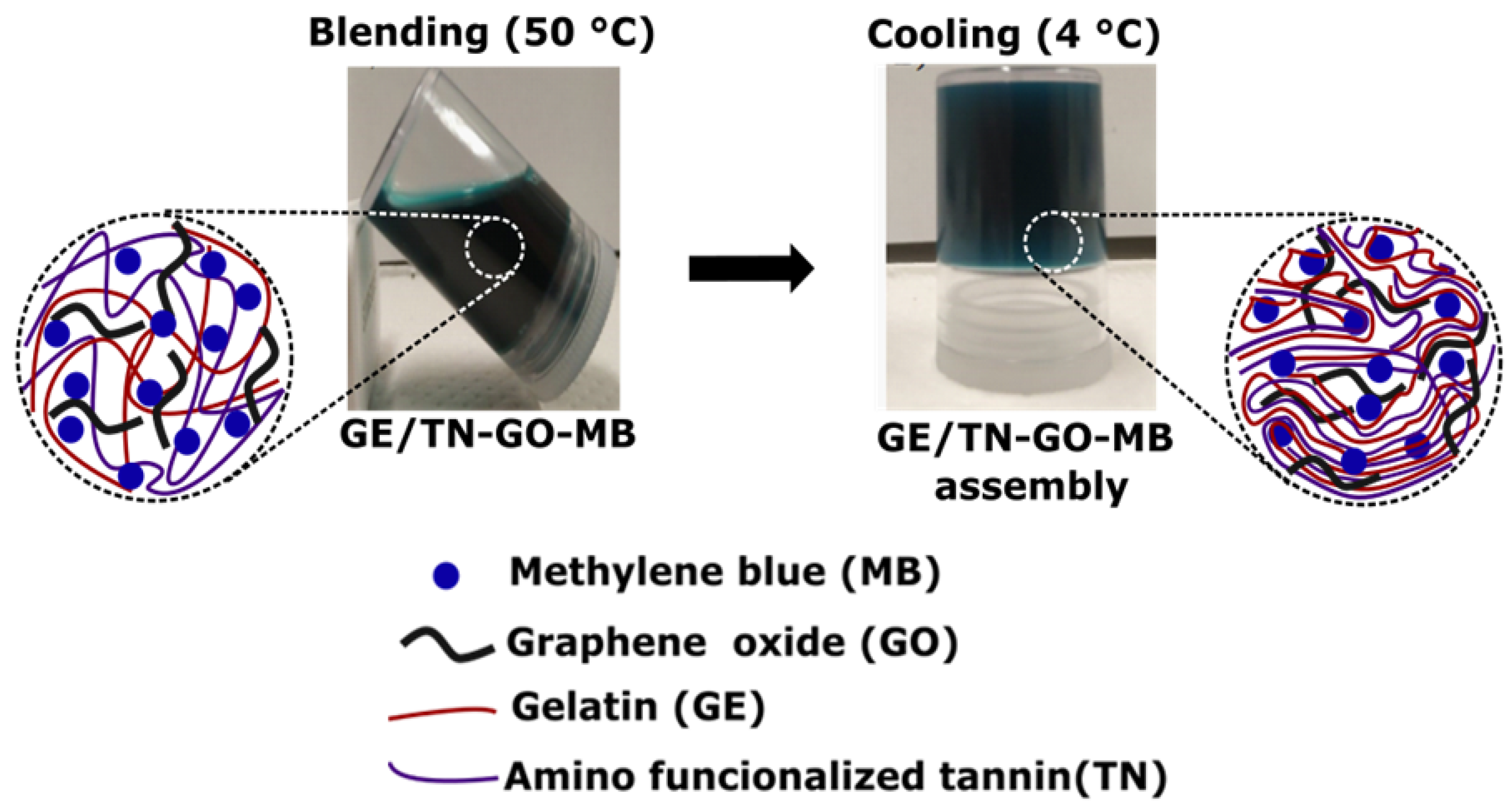
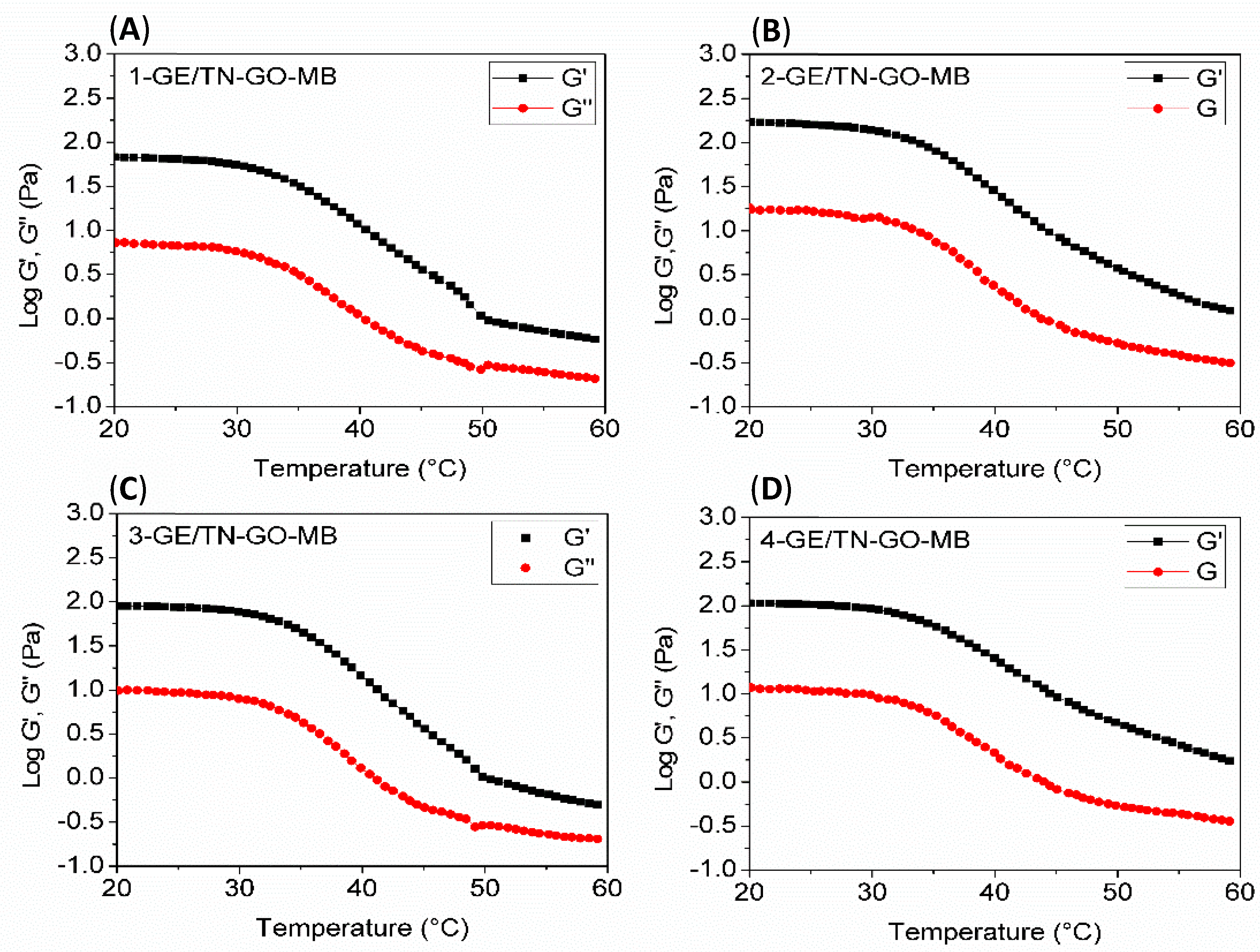
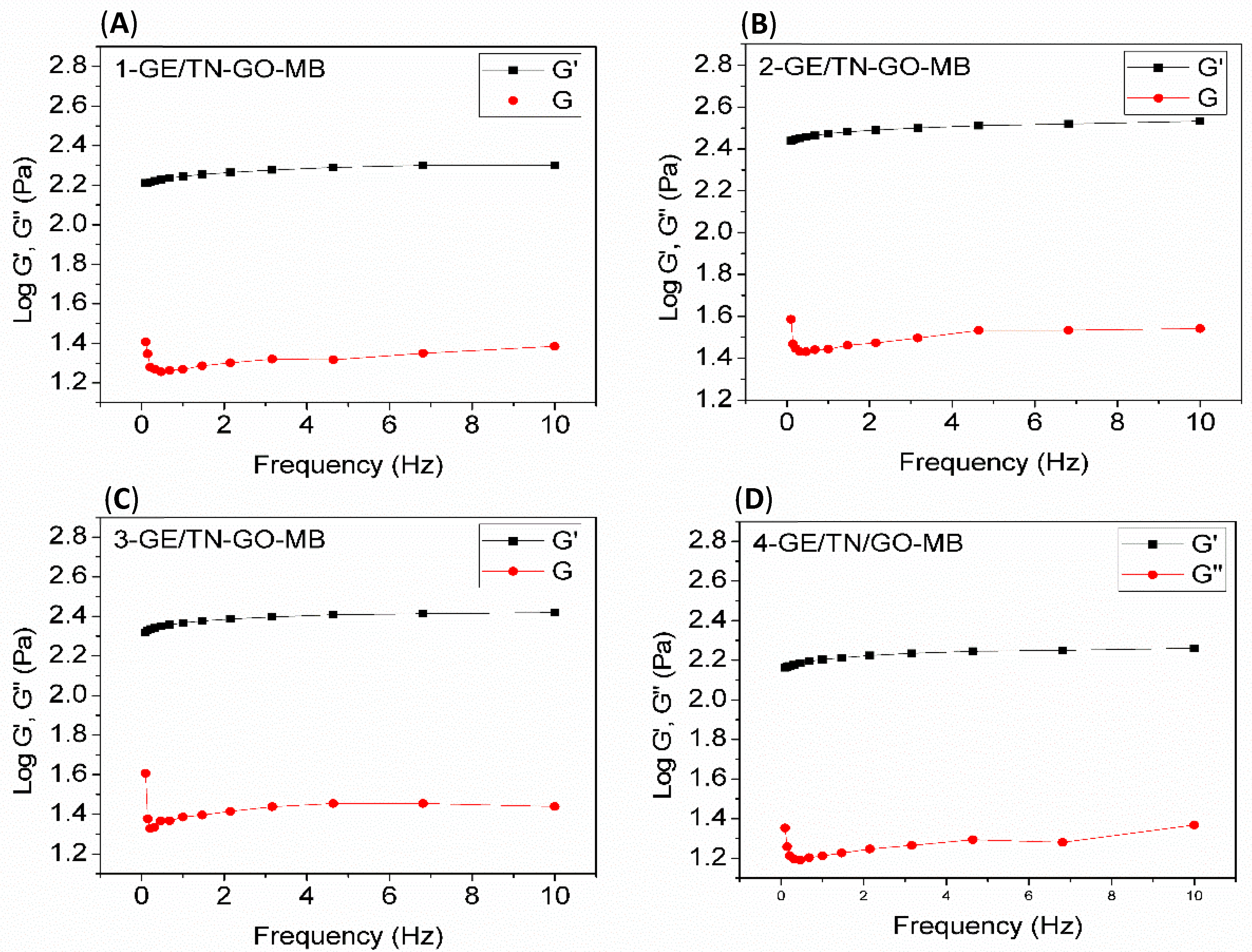
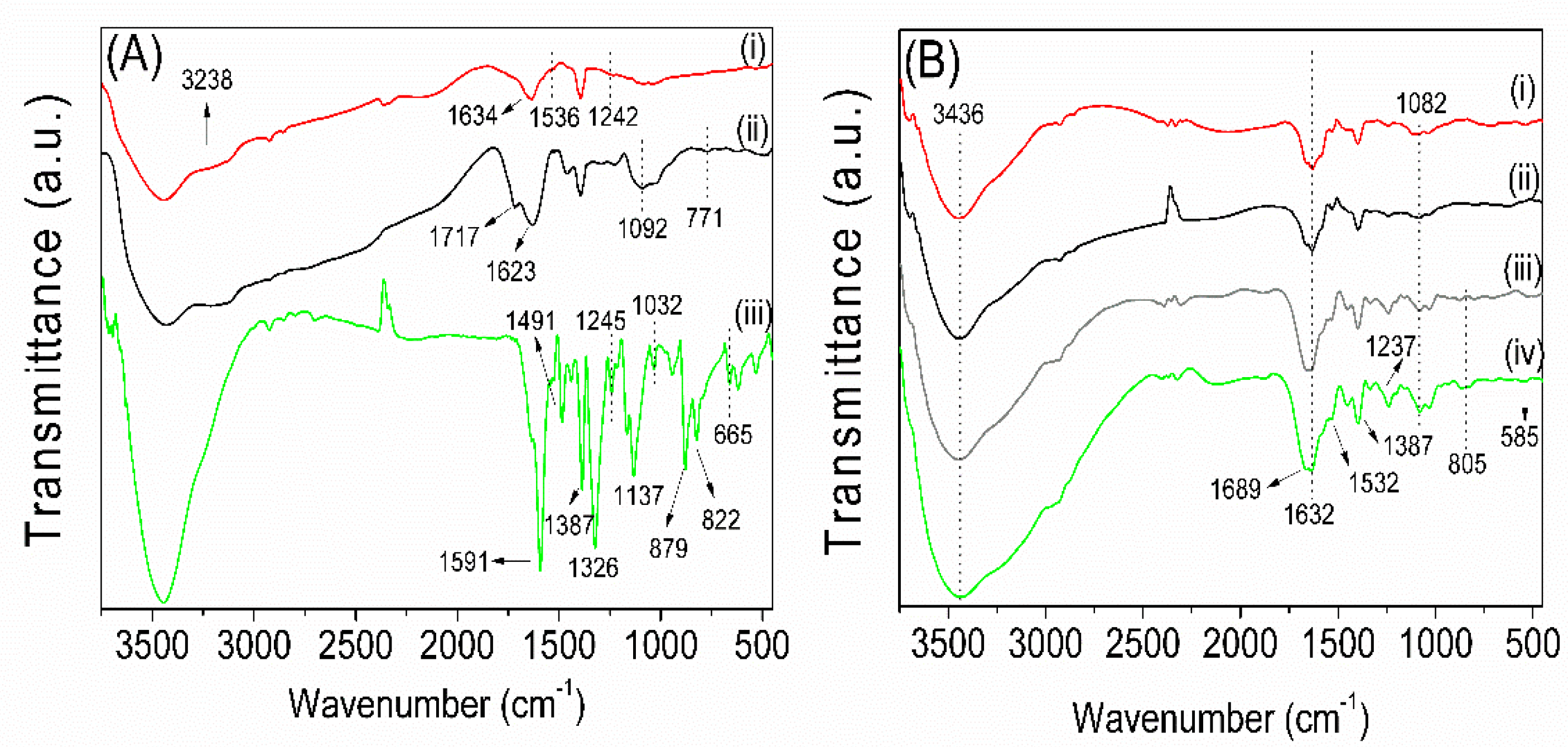
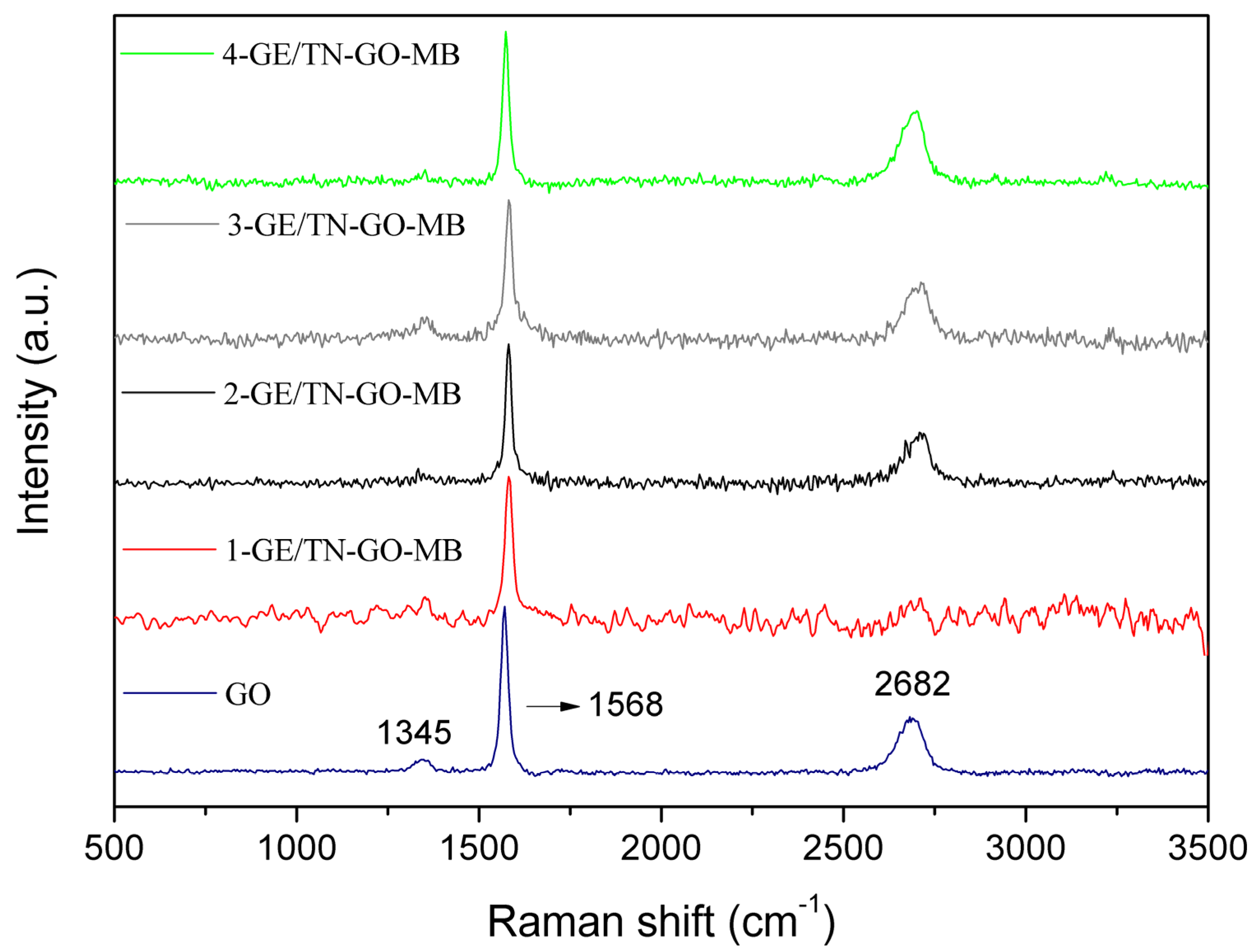
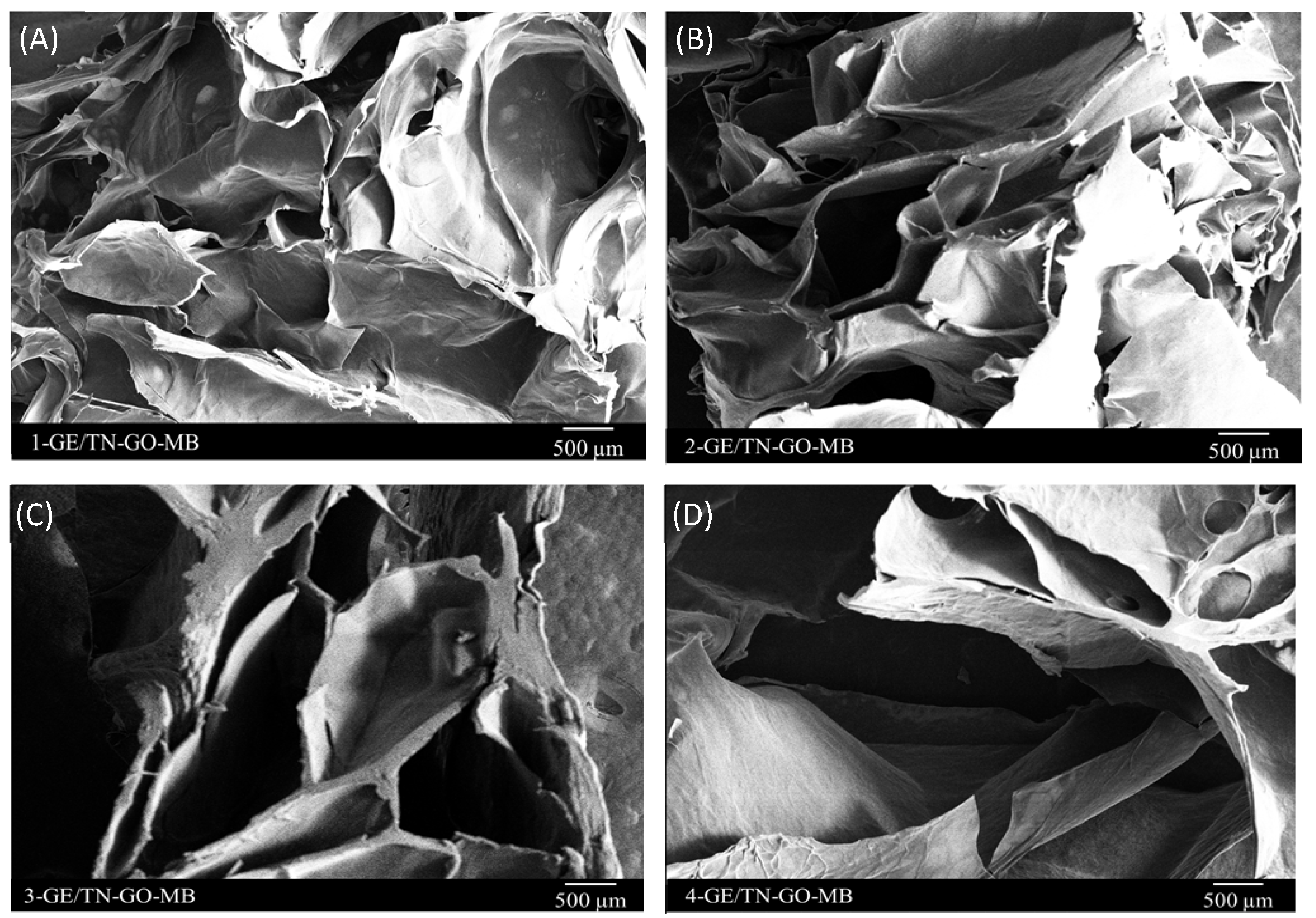
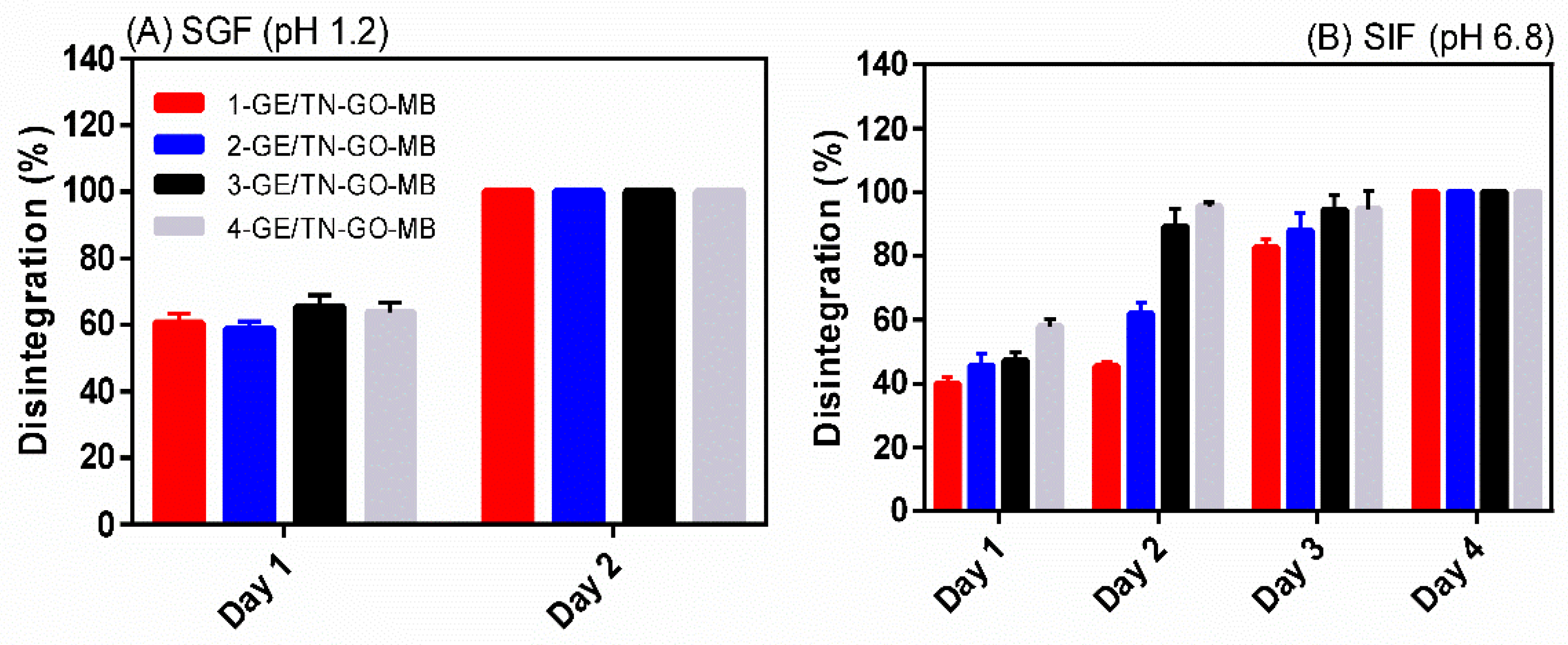
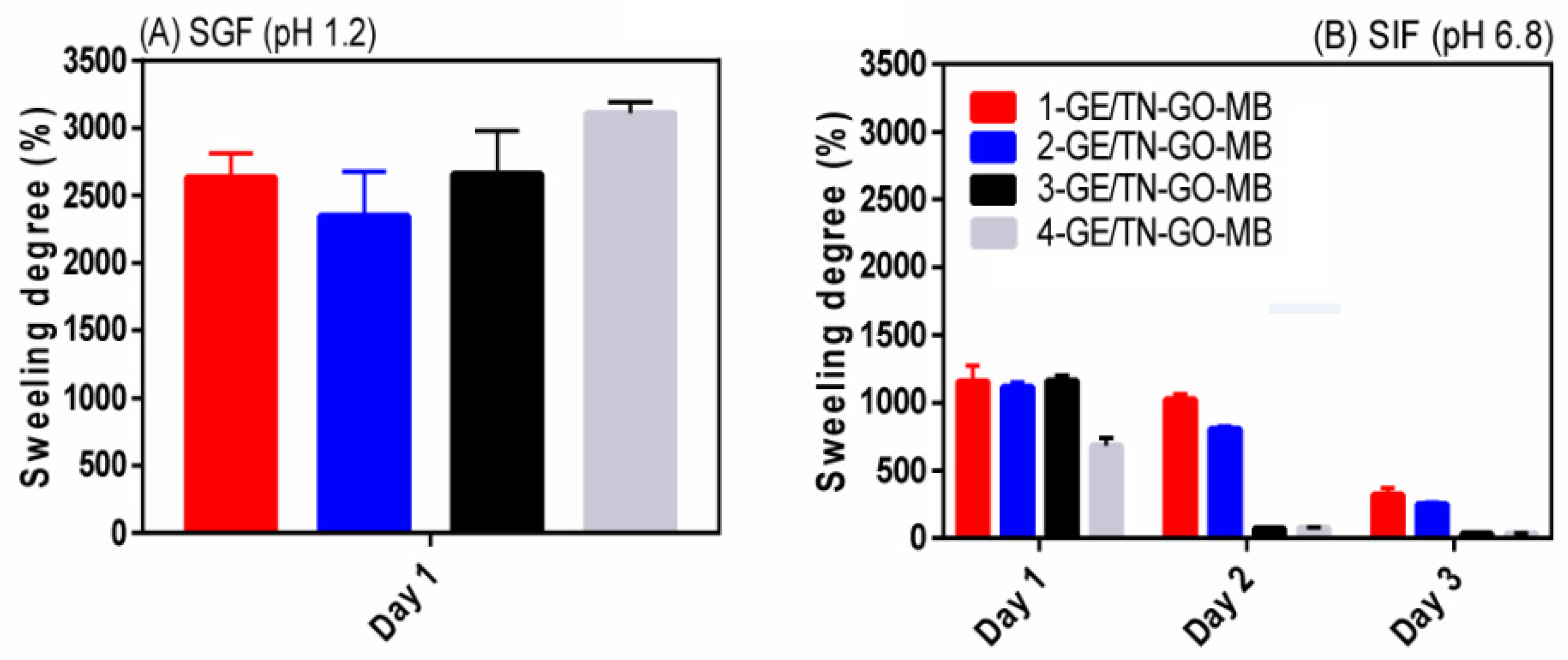
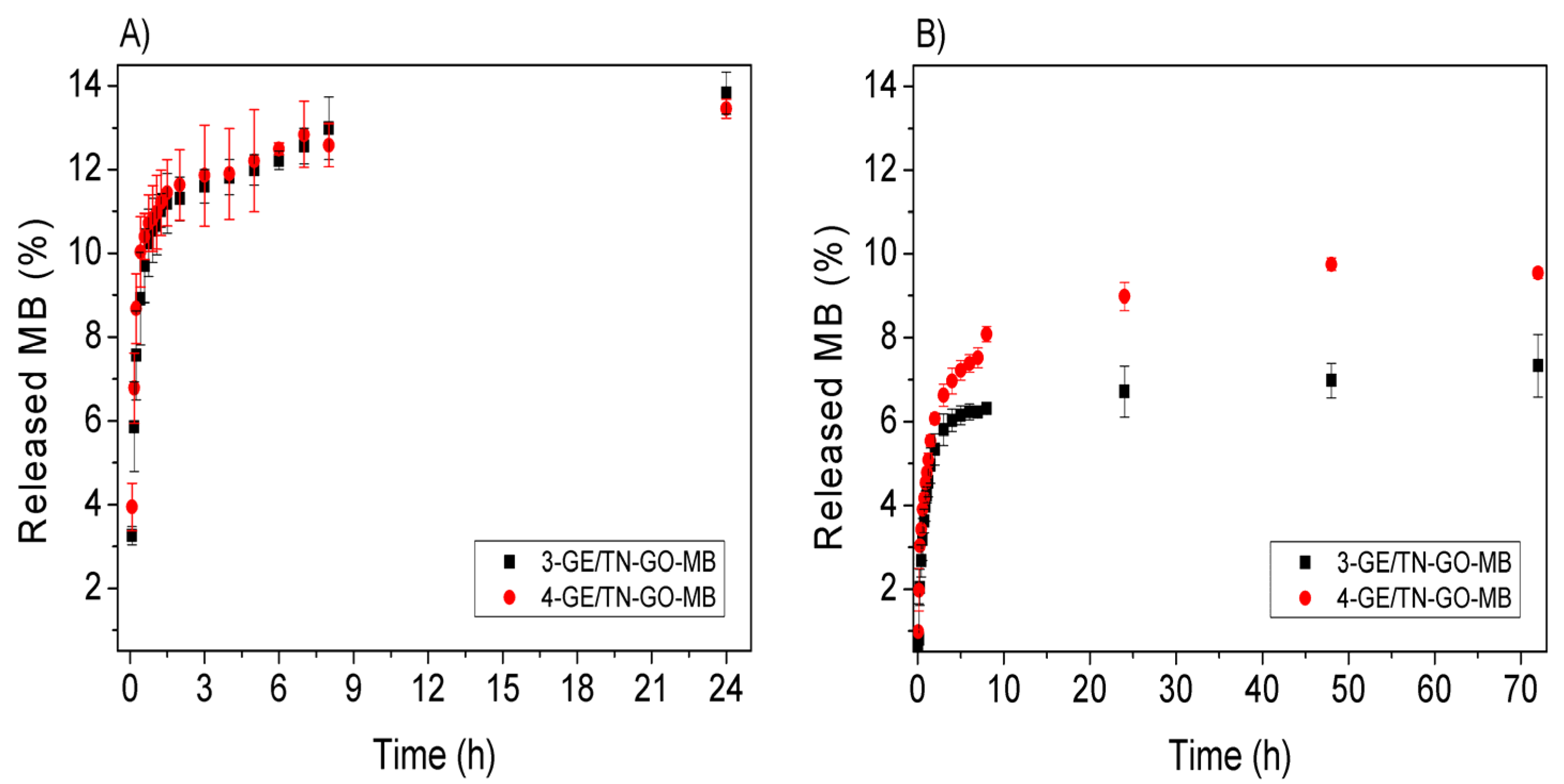
| Hydrogels | E (Pa) |
|---|---|
| GE/TN-MB 1-GE/TN-GO-MB | 516 ± 1.62 554 ± 1.06 |
| 2-GE/TN-GO-MB | 606 ± 3.13 |
| 3-GE/TN-GO-MB 4-GE/TN-GO-MB | 736 ± 5.61 1650 ± 33.62 |
| Hydrogels | n | k | R2 |
|---|---|---|---|
| 3-GE/TN-GO-MB(SGF) 4-GE/TN-GO-MB(SGF) | 0.18 0.18 | 9.54 9.86 | 0.92 0.87 |
| 3-GE/TN-GO-MB(SIF) 4-GE/TN-GO-MB(SIF) | 0.16 0.28 | 3.52 4.41 | 0.92 0.93 |
| Condition | Hydrogel | GO (% wt/wt) | GE + TN + GO + MB (mg) a | MB Concentration b (mg/mL) |
|---|---|---|---|---|
| 01 | 1-GE/TN-GO-MB | 0.31 | 67.86 | 0.13 |
| 02 | 2-GE/TN-GO-MB | 0.51 | 68.01 | 0.13 |
| 03 04 | 3-GE/TN-GO-MB 4-GE/TN-GO-MB | 0.71 1.02 | 68.14 68.35 | 0.13 0.13 |
Publisher’s Note: MDPI stays neutral with regard to jurisdictional claims in published maps and institutional affiliations. |
© 2021 by the authors. Licensee MDPI, Basel, Switzerland. This article is an open access article distributed under the terms and conditions of the Creative Commons Attribution (CC BY) license (https://creativecommons.org/licenses/by/4.0/).
Share and Cite
de Oliveira, A.C.; Souza, P.R.; Vilsinski, B.H.; Winkler, M.E.G.; Bruschi, M.L.; Radovanovic, E.; Muniz, E.C.; Caetano, W.; Valente, A.J.M.; Martins, A.F. Thermo- and pH-Responsive Gelatin/Polyphenolic Tannin/Graphene Oxide Hydrogels for Efficient Methylene Blue Delivery. Molecules 2021, 26, 4529. https://doi.org/10.3390/molecules26154529
de Oliveira AC, Souza PR, Vilsinski BH, Winkler MEG, Bruschi ML, Radovanovic E, Muniz EC, Caetano W, Valente AJM, Martins AF. Thermo- and pH-Responsive Gelatin/Polyphenolic Tannin/Graphene Oxide Hydrogels for Efficient Methylene Blue Delivery. Molecules. 2021; 26(15):4529. https://doi.org/10.3390/molecules26154529
Chicago/Turabian Stylede Oliveira, Ariel C., Paulo R. Souza, Bruno H. Vilsinski, Manuel E. G. Winkler, Marcos L. Bruschi, Eduardo Radovanovic, Edvani C. Muniz, Wilker Caetano, Artur J. M. Valente, and Alessandro F. Martins. 2021. "Thermo- and pH-Responsive Gelatin/Polyphenolic Tannin/Graphene Oxide Hydrogels for Efficient Methylene Blue Delivery" Molecules 26, no. 15: 4529. https://doi.org/10.3390/molecules26154529
APA Stylede Oliveira, A. C., Souza, P. R., Vilsinski, B. H., Winkler, M. E. G., Bruschi, M. L., Radovanovic, E., Muniz, E. C., Caetano, W., Valente, A. J. M., & Martins, A. F. (2021). Thermo- and pH-Responsive Gelatin/Polyphenolic Tannin/Graphene Oxide Hydrogels for Efficient Methylene Blue Delivery. Molecules, 26(15), 4529. https://doi.org/10.3390/molecules26154529








